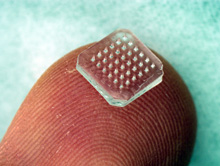Research
August 2, 2010
Vaccine patch promises easier shots

A new vaccine-delivery patch based on hundreds of microscopic needles that dissolve into the skin could allow persons without medical training to painlessly administer vaccines — while providing improved immunization against diseases such as influenza.
Patches containing micron-scale needles that carry vaccine with them as they dissolve into the skin could simplify immunization programs by eliminating hypodermic needles and concerns about their storage, re-use and disposal. Applied easily to the skin, the microneedle patches could allow self-administration of vaccine during pandemics and simplify large-scale immunization programs in developing nations.
The dissolving microneedle patches and immunization benefits observed in mice were described online July 18 in the journal Nature Medicine.
Just 650 microns in length and assembled into an array of 100 needles for the mouse study, the dissolving microneedles penetrate the outer layers of skin.
“The skin is a particularly attractive site for immunization because it contains an abundance of the types of cells that are important in generating immune responses to vaccines,” says Emory microbiologist Richard Compans.
Beyond their other advantages, the dissolving microneedles appear to provide improved immunity to influenza when compared to vaccination with hypodermic needles. Three months after mice were vaccinated with microneedles, they appeared to have a better “recall” response to the virus and thus were able to clear the virus from their lungs more effectively than those that received vaccine with hypodermic needles.
The microneedle arrays were made from a polymer material, poly-vinyl pyrrolidone, that has been shown to be safe for use in the body. Freeze-dried vaccine was mixed with the vinyl-pyrrolidone monomer before being placed into microneedle molds and polymerized at room temperature using ultraviolet light.
“The dissolving microneedle patch could open up many new doors for immunization programs by eliminating the need for trained personnel to carry out the vaccination,” says Georgia Tech biomedical engineer Mark Prausnitz.
In many parts of the world, poor medical infrastructure leads to the re-use of hypodermic needles, contributing to the spread of diseases such as HIV and hepatitis B. Dissolving microneedle patches would eliminate re-use while allowing vaccination to be done by personnel with minimal training.
If mass-produced, the microneedle patches are expected to cost about the same as conventional needle-and-syringe techniques, and may lower the overall cost of immunization programs by reducing personnel costs and waste disposal requirements, Prausnitz says. Before dissolving microneedles can be made widely available, however, clinical studies will have to be done to assure safety and effectiveness.
